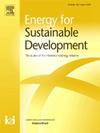生物氢生产的战略选址:通过农业生物质提高农村的可持续性
IF 4.9
2区 工程技术
Q2 ENERGY & FUELS
引用次数: 0
摘要
本研究开发了一个系统的多标准决策框架,以确定生物质制氢设施的最佳地点,强调发展中国家的可持续性和农村发展。我们引入了一种混合多标准决策(MCDM)方法,该方法将用于标准加权的最佳-最差方法(BWM)与用于备选排序的毕达哥拉斯模糊组合距离评估(PF-CODAS)相结合,实现了不确定性下的稳健评估。该标准是由经济市场因素、环境可持续性、资源利用、流程效率和安全因素组成的五支柱框架,通过29个子标准进行操作,并由7位领域专家提供信息。将这一方法应用于本文章由计算机程序翻译,如有差异,请以英文原文为准。
Strategic site selection for biohydrogen production: Enhancing rural sustainability through agricultural biomass
This study develops a systematic multi-criteria decision-making framework to identify optimal sites for biomass-based hydrogen production facilities, emphasizing sustainability and rural development in developing countries. We introduce a hybrid Multi-Criteria Decision-Making (MCDM) approach that integrates the Best–Worst Method (BWM) for criteria weighting with Pythagorean Fuzzy COmbinative Distance-based ASsessment (PF-CODAS) for alternative ranking, enabling robust evaluation under uncertainty. The criteria are structured as a five-pillar framework consisting of economic market factors, environmental sustainability, resource utilization, process efficiency, and safety considerations, operationalized via 29 sub-criteria and informed by seven domain experts. Applying this approach in Türkiye, five rural locations (Konya, Adana, Balıkesir, Şanlıurfa, Samsun) were assessed, using agricultural residues as the primary feedstock context. Konya ranked first and Adana second, reflecting strong logistics and market conditions and biomass availability alongside environmental performance. BWM results highlight GHG Emission Reduction as the highest weighted sub-criterion with Water Resource Utilization, and within process efficiency, Thermal Optimization is also prominent. A sensitivity analysis showed stable rankings for the top alternative, and comparative benchmarking against two well-known methods yielded consistent top two results, underscoring methodological robustness. This study highlights the significant potential of strategically located biomass-to‑hydrogen facilities to improve rural livelihoods, support local economies, and contribute to global sustainability goals by offering a viable alternative to traditional biomass use.
求助全文
通过发布文献求助,成功后即可免费获取论文全文。
去求助
来源期刊

Energy for Sustainable Development
ENERGY & FUELS-ENERGY & FUELS
CiteScore
8.10
自引率
9.10%
发文量
187
审稿时长
6-12 weeks
期刊介绍:
Published on behalf of the International Energy Initiative, Energy for Sustainable Development is the journal for decision makers, managers, consultants, policy makers, planners and researchers in both government and non-government organizations. It publishes original research and reviews about energy in developing countries, sustainable development, energy resources, technologies, policies and interactions.
 求助内容:
求助内容: 应助结果提醒方式:
应助结果提醒方式:


